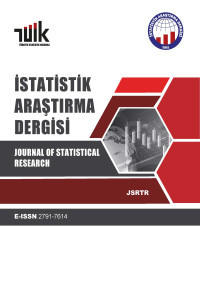MIDAS ve MF-VAR Modelleri ile GSYH Ön Tahmini
Büyüme Oranı, Gayrisafi Yurt İçi Hasıla, MF-VAR Modelleri, MIDAS Modelleri, Ön Tahmin
GDP Flash Estimate with MIDAS and Mixed Frequency VAR
Growth Rate, Gross Domestic Product, MF-VAR Models, MIDAS Models, Flash Estimate,
___
- Alper, C. E., Fendoğlu, S. ve Saltoğlu, B. (2012). MIDAS Volatility Forecast Performance Under Market Stress: Evidence From Emerging Stock Markets. Economics Letters, 117(2): 528-532.
- Al-Qawasmı, M. (2014). Forecasting Palestinian Gross Domestic Product Using Mixed Data Sampling Regression Techniques, Yüksek Lisans Tezi, Birzeit University.
- Anesti, N., Hayes, S. ve Moreira, A. (2017). Peering Into The Present: The Bank's Approach to GDP Nowcasting, Bank of England Quarterly Bulletin 2017 Q2.
- Aprigliano, V., Foroni, C., Marcellino, M., Mazzi, G. ve Venditti, F. (2017). A Daily Indicator of Economic Growth for The Euro Area. International Journal of Computational Economics and Econometrics, 7(1-2): 43-63.
- Armesto, M., Engemann, K. ve Owyang, M. (2010). Forecasting with Mixed Frequencies. Federal Reserve Bank of St. Louis Review, 92(6): 521-36.
- Berksun, D. (2019). Electricity Consumptıon And Economic Growth In Turkey: An MF-VAR Approach, Yüksek Lisans Tezi, Bilkent Üniversitesi, Ankara.
- Clements, M. P. ve Galvão, A. (2008). Macroeconomic Forecasting with Mixed-Frequency Data: Forecasting Output Growth in The United States. Journal of Business and Economic Statistics, 26(4): 546-54.
- Eurostat (2016). Overview Of GDP Flash Estimation Methods. Publications Office of The European Union, Luxembourg.
- Ferrara L. ve Marsilli, C. (2014). Nowcasting Global Economic Growth: A Factor-Augmented Mixed-Frequency Approach. Working Papers 515, Banque De France.
- Foroni, C., Marcellino, M. ve Schumacher, C. (2015). Unrestricted Mixed Data Sampling (MIDAS): MIDAS Regressions With Unrestricted Lag Polynomials. Journal of The Royal Statistical Society: Series A (Statistics In Society), 178(1): 57-82.
- Ghysels, E., Santa-Clara, P. ve Valkanov, R. (2004). The MIDAS Touch: Mixed Data Sampling Regression Models. California Digital Library, University Of California.
- Ghysels, E., Sinko, A. ve Valkanov, R. (2007). MIDAS Regressions: Further Results And New Directions. Econometric Reviews, 26(1): 53-90.
- Ghysels, E. ve Andreou, E. (2009). Structural Breaks in Financial Time Series. Handbook of Financial Time Series, Springer, Berlin.
- Ghysels, E. ve Kourtellos, A. (2010). Forecasting with Mixed-Frequency Data. Oxford Journal of Economic Forecasting, 158(1): 12.
- Ghysels, E., Hill, J. ve Motegi, K. (2015). Simple Granger Causality Tests for Mixed Frequency Data. Tohoku University.
- Ghysels, E. (2016). Macroeconomics and The Reality of Mixed Frequency Data. Journal of Econometrics, 193(2): 294-314.
- Ghysels, E., Hill, J. ve Motegi, K. (2016). Testing for Granger Causality with Mixed Frequency Data. Journal of Econometrics, 192: 207-230.
- Ghysels, E. ve Marcellino, M. (2018). Applied Economic Forecasting Using Time Series Methods. Oxford University Press, United States of America.
- Guliyev, H. (2018). Karma Frekanslı Verilerde MIDAS Regresyon Modellerinin Uygulanması: Türkiye’nin Ekonomik Büyüme Tahmini. Yüksek Lisans Tezi, Akdeniz Üniversitesi, Antalya.
- Günay, M. (2018). Nowcasting Annual Turkish GDP Growth With MIDAS. TCMB Ekonomi Notu.
- INE, Quarterly Spanish National Accounts, Press Release 2019Q2, Methodological Note, https://www.ine.es/en/daco/daco42/daco4214/cntr0219a_en.pdf [Ziyaret Tarihi: 15 Ağustos 2019]
- Kuzin, V., Marcellino, M. ve Schumacher, C. (2009). Pooling Versus Model Selection For Nowcasting with Many Predictors: An Application To German GDP. Deutsche Bundesbank Discussion Paper, Series 1: Economic Studies.
- Litterman R.B. (1983). A Random Walk, Markov Model for The Distribution of Time Series, Journal of Business And Economic Statistics, 1: 169-173.
- Marcellino, M. (1999). Some Consequences of Temporal Aggregation in Empirical Analysis. Journal of Business & Economic Statistics, 17(1): 129-136.
- Marsilli, C. (2017). Nowcasting US Inflation Using A MIDAS Augmented Phillips Curve. International Journal of Computational Economics And Econometrics, 7(1-2): 64-77.
- Schorfheide, F. ve Song, D. (2012). Real-Time Forecasting with a Mixed-Frequency VAR. Federal Reserve Bank of Minneapolis Research Department, Working Paper 701.
- Schumacher, C. (2014). MIDAS and Bridge Equations. Discussion Paper, Deutsche Bundesbank, No 26, Frankfurt.
- Sims, C. ve Zha, T. (1998). Bayesian Methods For Dynamic Multivariate Models. International Economic Review, 39(4): 949–968.
- TCMB, https://evds2.tcmb.gov.tr/ [Ziyaret Tarihi: 1 Haziran 2021]
- TÜİK, http://www.tuik.gov.tr/ [Ziyaret Tarihi: 1 Haziran 2021]
- Yamak, N. ve Samut, S. (2018). MIDAS Granger Nedensellik Testi (MF-VAR): GSYH ve İşsizlik Oranı. İktisat Seçme Yazılar, Celepler Matbaacılık Yayın Ve Dağıtım, Trabzon.
- Yamak, N., Samut, S. ve Koçak, S. (2018). Farklı Frekanslı Veriler Altında Ekonomik Büyüme Oranının Tahmini. Ekonomi Bilimleri Dergisi, 10(1): 35-47.
- ISSN: 1303-6319
- Başlangıç: 2002
- Yayıncı: TÜİK
Orta Gelir Tuzağı: N11 Ülkeleri Üzerine Bir İnceleme
Sayısal Bölünme Endeksi: Bilgi, Toplum ve Teknoloji
MIDAS ve MF-VAR Modelleri ile GSYH Ön Tahmini
Merve AYTEKİN, Furkan EMİRMAHMUTOGLU
Finansal Okuryazarlık Araştırmalarında Uluslararası Yayın Trendlerinin Bibliyometrik Analizi
